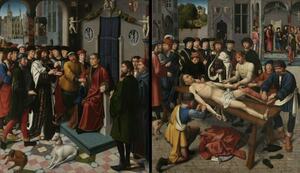From the Medieval Research Blog: "Medieval Justice: Reconciliation and Revenge in a Fifteenth-century City"
The following Medieval Research Blog story was written by our 2022–2023 A. W. Mellon Junior Faculty Fellow, Dr. Mireille Pardon, Assistant Professor of History at Berea College. Please join us for her colloquium this Friday, April 14, from 10 a.m. to 1 p.m. on her work. The colloquium will be held in person and via Zoom.
Learn More and Register for Zoom

Gerard David’s painting The Judgment of Cambyses was placed in the town hall of Bruges at the end of the fifteenth century. This diptych graphically depicts a gruesome tale from Herodotus in which King Cambyses II ordered a corrupt judge named Sisamnes to be flayed alive and the detached skin draped over his chair, as seen in the background of right panel. The image and its placement were part of the tradition of exempla iustitiae, providing moral lessons (or warnings) to urban administrators through images from legend and history. As a late medieval alderman, one should strive for impartiality so that one does not end up in Sisamnes’s position!
To my knowledge, no corrupt judges were even flayed alive in Bruges. Nor did the judges themselves ever sentence anyone to be flayed. However, rituals of bodily punishment could still involve visual spectacle. In 1488, around the time the town commissioned this painting and in the midst of a revolt against the Holy Roman Emperor Maximilian I (himself briefly imprisoned in the city), Bruges executed several high-ranking officials who had been loyal to Maximilian. Some suggest that the likeness of one such official, Pieter Lanchals, appears in this painting as Sisamnes. Although the real Pieter Lanchals was not flayed, his decapitated head was displayed on the city gates.
A rebellious city displaying the decapitated head of a detested politician fits well into popular stereotypes about the brutality of medieval justice. But was this representative of everyday judicial practice in Bruges and other Flemish cities in the fifteenth century? My research project is interested not in the infamous executions of political figures, or the iconography of imagined justice, but instead, ordinary judicial procedures and quotidian violence.
This is an excerpt from "Medieval Justice: Reconciliation and Revenge in a Fifteenth-century City" by Dr. Mireille Pardon (2022–2023 Mellon Fellow). Read the Full Story.